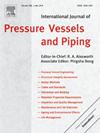油田制氮系统换热器T2铜管腐蚀失效分析
IF 3
2区 工程技术
Q2 ENGINEERING, MECHANICAL
International Journal of Pressure Vessels and Piping
Pub Date : 2025-04-03
DOI:10.1016/j.ijpvp.2025.105521
引用次数: 0
摘要
某油田制氮系统的立式管壳式换热器,在使用仅一年后,内部换热管就发生了射孔故障。采用目测、扫描电镜(SEM)、x射线光电子能谱(XPS)和x射线衍射(XRD)分析了失效管的腐蚀形貌和化学成分。通过动电位极化(PDP)测试,研究了温度在30 ~ 90℃范围内对T2铜腐蚀行为的影响。利用循环釜研究了T2铜在静态和动态条件下的均匀腐蚀和点蚀行为。结果表明:溅射区腐蚀产物膜厚度为10.12 μm,动态水线区腐蚀产物膜厚度为105.8 μm;在浸没区没有观察到明显的腐蚀或结垢迹象。腐蚀强度随温度升高而增大,动态腐蚀比静态腐蚀严重。动态条件下,动态水线区点蚀速率高达1.666 mm/y,而浸没区几乎没有发生点蚀。在飞溅区和动态水线区,液膜经历了连续的形成和蒸发循环,导致Ca2+、CO32−和Cl−浓度增加。这些离子浓度的升高促进了松散和多孔腐蚀产物的产生,如CaCO3、Cu2(OH)3Cl和Cu2(OH)2CO3,从而促进了沉积下腐蚀。此外,动态水线区域的循环水扰动导致腐蚀产物频繁脱落,最终导致局部腐蚀导致射孔。本文章由计算机程序翻译,如有差异,请以英文原文为准。
Corrosion failure analysis of T2 copper tubes of a heat exchanger in the oilfield nitrogen production system
In a vertical shell-and-tube heat exchanger of the nitrogen production system in an oilfield, perforation failure of the internal heat exchange tubes occurred after only one year of service. The corrosion morphology and chemical composition of the failed tube were analyzed by visual examination, scanning electron microscope (SEM), X-ray photoelectron spectroscopy (XPS), and X-ray diffraction (XRD). The influence of temperatures ranging from 30 °C to 90 °C on the corrosion behavior of T2 copper was investigated through potentiodynamic polarization (PDP) testing. The uniform corrosion and pitting corrosion behaviors of T2 copper under static and dynamic conditions were separately studied using a circulating flow autoclave. The results indicate that the thicknesses of the corrosion product films are 10.12 μm in the splash zone and 105.8 μm in the dynamic waterline zone, respectively. No significant signs of corrosion or scaling were observed in the immersion zone. Corrosion intensity increases with rising temperature, and corrosion is more severe under dynamic conditions than under static conditions. Under dynamic conditions, the pitting corrosion rate in the dynamic waterline zone reached as high as 1.666 mm/y, whereas almost no pitting corrosion took place in the immersion zone. In the splash and dynamic waterline zones, liquid films experience continuous cycles of formation and evaporation, resulting in increased concentrations of Ca2+, CO32−, and Cl−. These elevated ion concentrations promote the generation of loose and porous corrosion products such as CaCO3, Cu2(OH)3Cl, and Cu2(OH)2CO3, which facilitate under-deposit corrosion. Furthermore, circulating water disturbances in the dynamic waterline area cause frequent detachment of corrosion products, ultimately leading to perforation due to localized corrosion.
求助全文
通过发布文献求助,成功后即可免费获取论文全文。
去求助
来源期刊
CiteScore
5.30
自引率
13.30%
发文量
208
审稿时长
17 months
期刊介绍:
Pressure vessel engineering technology is of importance in many branches of industry. This journal publishes the latest research results and related information on all its associated aspects, with particular emphasis on the structural integrity assessment, maintenance and life extension of pressurised process engineering plants.
The anticipated coverage of the International Journal of Pressure Vessels and Piping ranges from simple mass-produced pressure vessels to large custom-built vessels and tanks. Pressure vessels technology is a developing field, and contributions on the following topics will therefore be welcome:
• Pressure vessel engineering
• Structural integrity assessment
• Design methods
• Codes and standards
• Fabrication and welding
• Materials properties requirements
• Inspection and quality management
• Maintenance and life extension
• Ageing and environmental effects
• Life management
Of particular importance are papers covering aspects of significant practical application which could lead to major improvements in economy, reliability and useful life. While most accepted papers represent the results of original applied research, critical reviews of topical interest by world-leading experts will also appear from time to time.
International Journal of Pressure Vessels and Piping is indispensable reading for engineering professionals involved in the energy, petrochemicals, process plant, transport, aerospace and related industries; for manufacturers of pressure vessels and ancillary equipment; and for academics pursuing research in these areas.

 求助内容:
求助内容: 应助结果提醒方式:
应助结果提醒方式:


